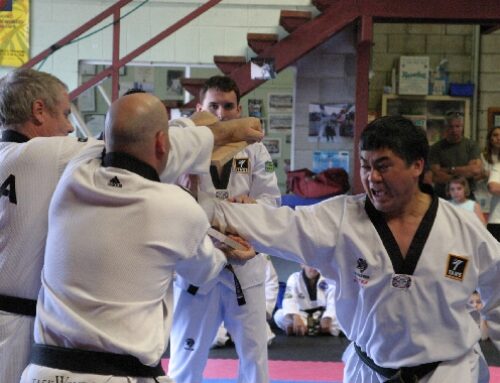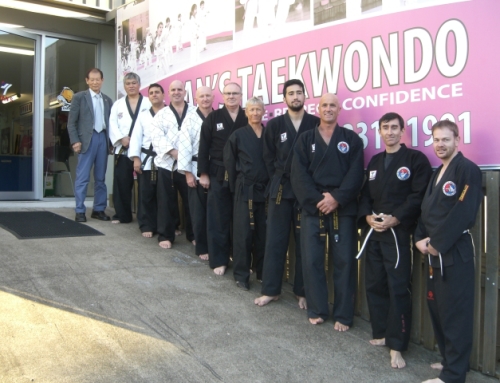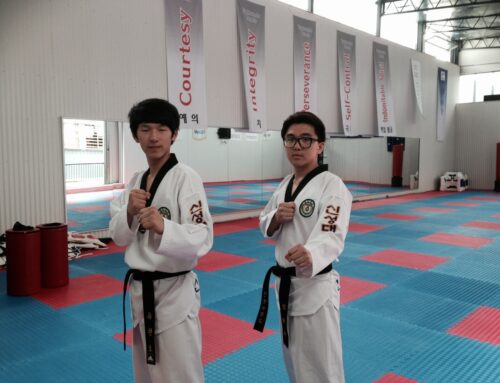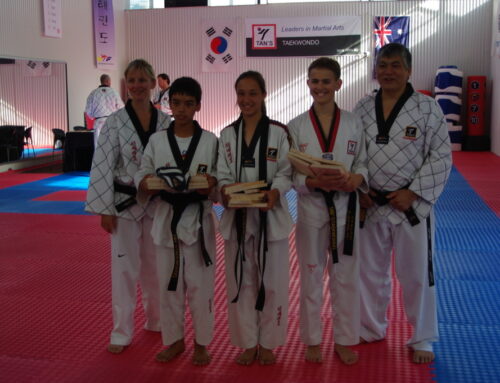
Dang Jeon Breathing
The following was wriiten by Terje Svingen 5th Dan Hapkido.
There is however, no denying that Hapkido is a system designed to teach practitioners
fighting skills to defeat any potential adversaries. However, this is obviously a
simplistic view, not taking into account the broader teachings – typically applicable to
any Martial Arts – that also focus on the development of the human spirit through
both physical and mental exercise. The teachings of Hapkido have a strong emphasis
on non-violence, spiritual balance and harmony within oneself and the surrounds.
These are not necessarily attributes that are easily achieved and must therefore be
cultivated and constantly reinforced throughout life.
Traditionally, the philosophical aspect of Martial Arts training was at the centre, but
in a more modern society the focus on victory through physical prowess has had a
stronger tendency to come to the forefront in many styles. The emergence of Judo and
Taekwondo as Olympic sports are specific examples, and also the recent popularity of
Mixed Martial Arts (MMA) – or cage fighting – has had great influence on how many
Martial Arts are now taught and understood. Here, the focus is on victory by
conquering the opponent through brute force, technical prowess and little or no
consideration to what damage it may cause in the process. It is by no means a modern
phenomenon however, as the propensity for violence has marred the human race
throughout history. To quote the French scientist and philosopher Blaise Pascal
(1623-1662): “It is the fight alone that pleases us, not the victory”. These words ring
as true today as in years gone by.
With regard to Hapkido, it too teaches offensive techniques and empowers the
practitioner with the ability to inflict great harm to an opponent. However, this is
taught to be a last resort and the ideology is to first avoid conflict. If that is not
enough, the aim becomes to avert conflict by redirecting aggression. This can be done
in a manner that either spares or harms the aggressor, and the former should be the
preferred option. Nevertheless, great harm can be inflicted on the adversary if the
situation calls for it. In truth, it is this knowledge that largely empowers the Hapkido
practitioner to diffuse conflict in a non-violent and harmonious manner. That is;
knowledge of strength allows for peaceful action. But how then does the principle of
non-aggression actually work? It is generally explained, and widely understood, from
the three key principles of Hapkido philosophy: non-resistance, circular motion and
harmony. Here, they will not be defined and discussed separately, but rather reflected
upon from a more holistic viewpoint.
All people occupy a certain space that extends in all directions from each person’s
centre of gravity, or ‘centre of ki’. This concept is easily visualised as a person inside
a translucent balloon, like a Vitruvian man in three dimensions. The space inside the
outer limits of this invisible sphere belongs to the individual and can, through
practice, be controlled to become a personal sphere of positive energy, mental and
physical balance, and harmony. It is however, not a rigid sphere, but better understood
as energies without physical matter; like waves through water or air. And the
spherical boundaries are constantly shifting and intercepting other energies, as they
should be. Trying to avoid this will cause conflict with the surrounds, which is the
exact opposite outcome of what one tries to achieve. The important point is to control
the sphere, so that anything entering it, or trying to disrupt it, becomes controllable. In
that way, one can move around freely and without conflict.
As an example, you are being attacked by an aggressor. By simply counteracting, you
will lose control of your own sphere – it will become inharmonious – and the two
spheres will collide and create negative forces. To maintain balance and harmony, this
direct conflict should be avoided and negative energy is best defeated by positive
energy. For instance, one may meet the aggressor by stepping forward, but not to
counteract, but to greet; to invite the aggressor into one’s own sphere. The simple act
of ‘greeting’ is essential as it implies a positive act. Through practice, one should
always strive at maintaining a positive energy, even when faced with an aggressor
emitting negative energy. The positive energy will thus have the potential to absorb
the negative energy, whereas the meeting of two negative forces will repel each other
and cause destruction.
Once the attacker has entered your sphere, they can be controlled by circular motion
and redirection of energy as long as your mind and body are harmonious. When the
opponent pushes, pull. When the opponent pulls, push. When greeting an attacker,
greet at an angle and pass over. By controlling a single point on the attacker in this
instance – for instance grabbing hold of a wrist – the force created by the attacker will
pivot around this singular point and cause the opponent to lose balance. The attacker
becomes something controllable; an extension of oneself. The motions are felt before
they are initiated, like a dance where you control both bodies at once.
In theory, this principle sound relatively simple and does not take too much effort to
appreciate when practicing together with a likeminded partner. In reality however, it
becomes immensely difficult. Only through repetitive practicing and constant
readjustment does it become truly achievable. It becomes more a matter of controlling
the opponent’s mind rather than body. The controlling of the physical body becomes
merely an expression of wilful thought. It becomes an intuitive reaction to an action
where the positive and harmonious mind controls the negative and weak. And,
although sounding thus, it is not a meta-physical phenomenon.
As an example, this intuitive reaction to an attack can be better understood through a
common sport such as table-tennis, or ping pong. Anyone who has tried to play this
very fast game has quickly come to realise how difficult, if not impossible, it is to
follow the trajectory of the small plastic ball in order to position the bat to hit it back
across the net. In fact, by measuring the speed of the ball when professional players
hit it, it is physically impossible for any human being to first see where the ball is
flying and then react to hit it. The hitting of the fast-paced ball is only achieved
through reading of the other player’s body motion and angle of the hitting arm. So,
when an amateur faces a professional across the ping pong table, he or she will not
see what is coming and not stand a chance of returning. Only through years of
practice does the reading of another player’s body motion become an intuitive action.
One of the chief goals for a Hapkido student is to reach this level of control to achieve
victory through the mind only. By predicting what is to come, the experienced
practitioner can choose the least confrontational action by intuition. But it requires
that the mind always stay calm and positive, which can be difficult under pressure. It
also extends far beyond being attacked physically, in or outside the dojang. It extends
to life as a whole.
As humans we face challenges on a regular basis throughout life. It may be a
confrontation with a friend or a partner, a family dispute, a showdown with a
colleague or a boss. It may be on a political arena, in a courthouse, or on a football
field. The principles of diffusing negative energy with positive by opposing actions,
deflecting attacks – verbal, physical or mental – by circular motion, are in essence the
same regardless of the situation. Such juxtaposing of principles of warfare into
everyday life has famously been attempted by the business world through the reading
and analysing of Sun Tzu’s The Art of War. While such undertakings are far from
futile, it requires the reader to fully appreciate the thinking process of a warrior, or
practitioner of Martial Arts as in the case of Hapkido, and not in the least the sincere
patience. The ability to achieve victory by avoiding defeat is not necessarily come by
through simply reading a textbook. Nevertheless, it seems fitting to conclude with a
quote from The Art of War itself: “The supreme art of war is to subdue the enemy
without fighting.” This must be a worthy goal for any human being in any life pursuit.






Leave A Comment